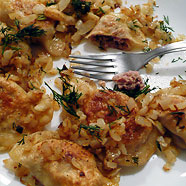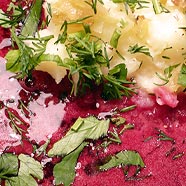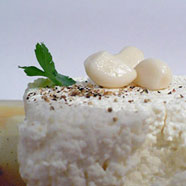Authentic Polish Recipes — the best traditional collection online
Polish food has its admirers around the world. Now, using our Polish recipes collection, you can get to know how to prepare most of the characteristic and delicious meals of the Polish cuisine. Tasting Poland introduces a comprehensive set of authentic Polish recipes, which are very popular in Poland, and prepared on a common basis. You will learn how to prepare Polish foods in a quick and hassle-free manner.
Here, I made every effort to publish Polish recipes, that are explained in enough detail, since oftentimes the success of the food we prepare depends on the respective details. The majority of Polish food recipes on Tasting Poland is well-tried – these are reliable recipes I have tried myself, and they are based on authentic, original Polish cookbooks and culinary traditions. I genuinely hope that you will find helpful this authentic Polish recipe collection, and a true added value to the English-speaking Internet :) Good luck and Smacznego! (Article continues below).

Original recipes for Polish first courses
-
 Pierogi dough recipe
Ciasto na pierogi (ciasto pierogowe)
Pierogi dough recipe
Ciasto na pierogi (ciasto pierogowe)
-
 Pierogi with meat filling
Miesne nadzienie do pierogow
Pierogi with meat filling
Miesne nadzienie do pierogow
-
 Pierogi or uszka with mushroom & cabbage filling
Pierogi lub uszka - nadzienie z kapusta i grzybami
Pierogi or uszka with mushroom & cabbage filling
Pierogi lub uszka - nadzienie z kapusta i grzybami
-
 Uszka for the Christmas Eve clear borscht
Uszka do barszczu wigilijnego
Uszka for the Christmas Eve clear borscht
Uszka do barszczu wigilijnego
-
 Pierogi with bilberries, blueberries or strawberries
Pierogi z jagodami lub truskawkami
Pierogi with bilberries, blueberries or strawberries
Pierogi z jagodami lub truskawkami
-
 Pierogi with white mushrooms and eggs
Pierogi z pieczarkami i jajkiem
Pierogi with white mushrooms and eggs
Pierogi z pieczarkami i jajkiem
-
 Bigos (Hunter's stew) from young cabbage
Bigos z mlodej kapusty
Bigos (Hunter's stew) from young cabbage
Bigos z mlodej kapusty
-
 White cabbage stewed with neck
Biala kapusta duszona z karkowka
White cabbage stewed with neck
Biala kapusta duszona z karkowka
-
 Scrambled eggs with chanterelle mushrooms
Jajecznica z kurkami
Scrambled eggs with chanterelle mushrooms
Jajecznica z kurkami
-
 Knedle dumplings with poppy filling
Knedle z makiem
Knedle dumplings with poppy filling
Knedle z makiem

Original recipes for Polish soups
-
 Zur aka zurek soup recipe (from homemade sourdough)
Zur, zurek
Zur aka zurek soup recipe (from homemade sourdough)
Zur, zurek
-
 White borscht recipe
Bialy barszcz
White borscht recipe
Bialy barszcz
-
 Red borscht with mushrooms for Christmas Eve supper
Czerwony barszcz z grzybami na Wigilie
Red borscht with mushrooms for Christmas Eve supper
Czerwony barszcz z grzybami na Wigilie
-
 Red borscht with cream and potato
Czerwony barszcz zabielany z ziemniakami
Red borscht with cream and potato
Czerwony barszcz zabielany z ziemniakami
-
 Ukrainian borscht 1
Barszcz ukrainski 1
Ukrainian borscht 1
Barszcz ukrainski 1
-
 Simple Ukrainian borscht 2
Barszcz ukrainski 2
Simple Ukrainian borscht 2
Barszcz ukrainski 2
-
 Polish flaki aka flaczki soup - beef tripe 1
Flaki, flaczki
Polish flaki aka flaczki soup - beef tripe 1
Flaki, flaczki
-
 'Flaki po polsku', tripe in a Polish manner
Flaki po polsku
'Flaki po polsku', tripe in a Polish manner
Flaki po polsku
-
 Polish sorrel soup - szczawiowa
Barszcz szczawiowy / zupa szczawiowa
Polish sorrel soup - szczawiowa
Barszcz szczawiowy / zupa szczawiowa
-
 Polish dill soup soup - koperkowa
Zupa koperkowa
Polish dill soup soup - koperkowa
Zupa koperkowa
-
 Ogorkowa - Polish cucumber soup recipe
Zupa ogorkowa
Ogorkowa - Polish cucumber soup recipe
Zupa ogorkowa
-
 Tomato soup recipe (zupa pomidorowa)
Zupa pomidorowa
Tomato soup recipe (zupa pomidorowa)
Zupa pomidorowa
-
 Chlodnik - traditional cold borscht recipe 1
Chlodink 1
Chlodnik - traditional cold borscht recipe 1
Chlodink 1
-
 Chlodnik - traditional cold borscht recipe 2
Chlodnik 2
Chlodnik - traditional cold borscht recipe 2
Chlodnik 2
-
 Goulash soup
Zupa gulaszowa
Goulash soup
Zupa gulaszowa
-
 Polewka kurpiowska - Soup of the Kurpie region
Polewka kurpiowska
Polewka kurpiowska - Soup of the Kurpie region
Polewka kurpiowska
-
 Old Polish onion soup
Staropolska zupa cebulowa
Old Polish onion soup
Staropolska zupa cebulowa
-
 Old Polish beer soup
Staropolska zupa piwna
Old Polish beer soup
Staropolska zupa piwna
-
 Morello cherry soup
Zupa wisniowa
Morello cherry soup
Zupa wisniowa

Original recipes for Polish appetizers and desserts
-
 Unbaked cheesecake with biscuits bottom and jelly
Sernik z galaretka i spodem z herbatnikow
Unbaked cheesecake with biscuits bottom and jelly
Sernik z galaretka i spodem z herbatnikow
-
 Old Polish dried mushroom sauce
Staropolski sos z suszonych grzybow
Old Polish dried mushroom sauce
Staropolski sos z suszonych grzybow
-
 Old Polish fresh mushroom sauce
Staropolski sos ze swiezych grzybow
Old Polish fresh mushroom sauce
Staropolski sos ze swiezych grzybow
-
 Rhubarb sorbet
Sorbet rabarbarowy
Rhubarb sorbet
Sorbet rabarbarowy
-
 Kluski z makiem - pasta with poppy
Kluski z makiem
Kluski z makiem - pasta with poppy
Kluski z makiem
-
 Simple sweet curd cheese sandwiches
Kanapki ze slodkim twarozkiem
Simple sweet curd cheese sandwiches
Kanapki ze slodkim twarozkiem
Polish food traditions
Traditional Polish cuisine is quite rich. Diversity and refinement are crucial, thanks to the culinary traditions of people living side by side for centuries: Jews, Ukrainians, Belarusians, Lithuanians and Ukrainians. The influence of Russia, Germany, Czech Republic and Austria should also be mentioned.
Within Polish cuisine, you can find specialties recognized around the world and Tasting Poland is here to let you know more about them and to discover Polish recipes. Let me introduce some basic Polish menus by describing how a typical Polish lunch looks like. So, traditionally Polish lunch/dinner, called in Polish 'obiad', is served at 2-3 p.m. in two servings. The first one is a Polish soup which usually is a:
- rosol which is a chicken soup (broth with poultry or beef, served with pasta, sprinkled with plenty of greens),
- zurek (soup made from soured rye flour and meat, served with potatoes chopped into cubes, sausage, and hardboiled egg),
- red borsch (beet concoction, served with small dumplings with mushroom or bean stuffing - this is called uszka and is similar to Polish pierogi).
- Quite often at the Polish table, we can also find other popular soups, including a cabbage soup, barley soup, or tomato soup.
A culmination of the late lunch is the "second course" (drugie danie). Actually, it is what is commonly understood as a first course (or main) in English, but Poles call it the second (the soup goes first). Polish recipes for first courses are listed in a table above, while a short list of some popular foods served as seconds is below:
- kotlet schabowy, pork chops in a coating served with potatoes and stewed cabbage,
- roasted chicken with potatoes or fries + cucumber salad called mizeria,
- kotlet mielony, ground cutlet with potatoes and vegetables,
- some kind of Polish dumplings (which I love!:), like kopytka, pyzy, kluski slaskie sprinkled with pork scratchings, fried onion or covered with meat sauce like goulash,
- especially delicious and traditional Polish first courses are pierogi, golabki (cabbage rolls in tomato sauce) and bigos (Polish hunter's stew), but these recipes require more time to be prepared and therefore in many Polish families are not every-day but rather a 'festive' meals,
- I should also mention that many Poles like to eat sweet dishes also for a dinner. A good example is provided by nalesniki (Polish-style pancakes made from a very thin dough), knedle (dumplings stuffed with plums or poppy seeds), pierogi with a sweet curd cheese or noodles with fruit mousses. We have published recipes for these Polish specialties, as well.
Lunch usually ends with a Polish dessert. In Poland, homemade cakes are commonly served. Specialties worth a try are: yeast cake, makowiec (roll with poppy seeds and dried fruits), mazurek, ciders, piernik (ginger cake) and delicious Polish cheesecakes. For those who like to enjoy a special, gourmet taste, we suggest to try paczki (Polish donuts) filled with rose jam.
All Polish recipes here are written in a friendly way, so even people who usually do not like to cook, or who don't know how to cook, can easily prepare some Polish food. Most of the recipes are written for a family of four, but if double or triple the quantities per ingredient, you will get a recipe for a party.